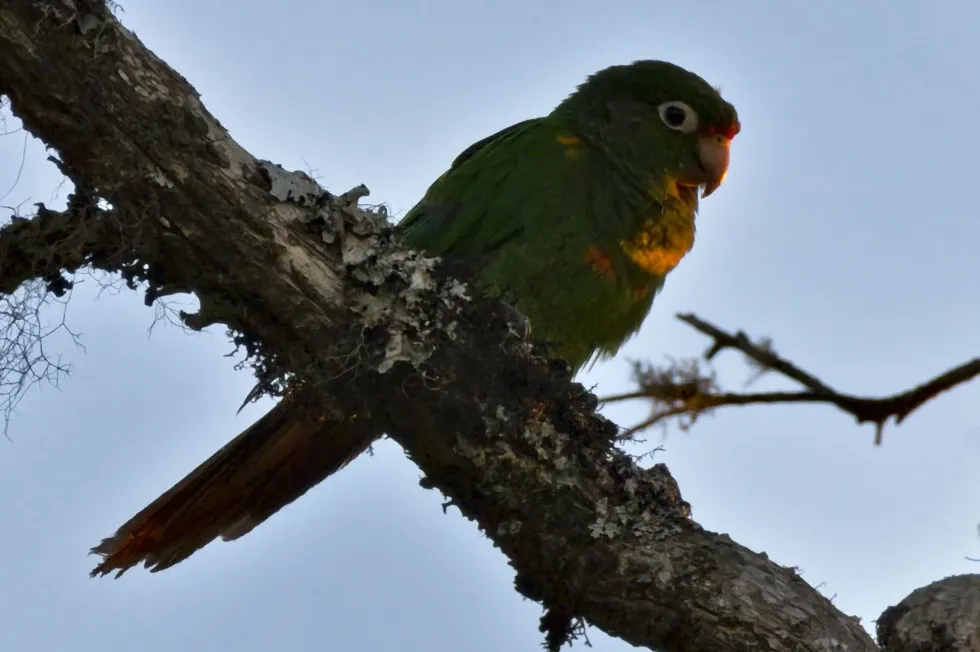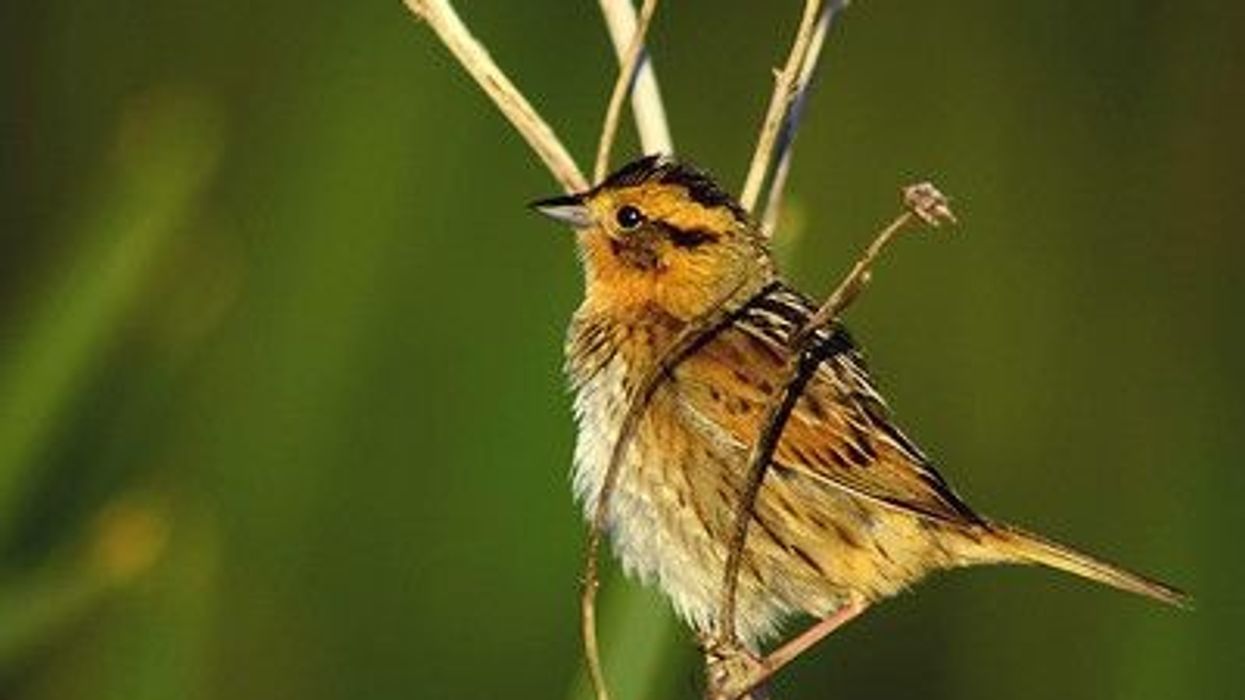The Santa Marta parakeet (Pyrrhura viridicata), also known as the Santa Marta conure, is a small green parakeet belonging to the Psittacidae family which can be found in the tropical and subtropical montane region of Columbia. It is a nonmigratory bird that spends its days foraging for fruits, seeds, and flowers in flocks to fuel its herbivore diet.
They can often be found darting above the dense green forest canopy in noisy groups, displaying acrobatic feats.
Their wings are tipped in orange and bright blue which makes for a beautiful sight to behold when they spread their wings and fly. However, these colorful birds face extinction as their habitat as well as the population is in rapid decline due to habitat loss.
The tropical forests which these birds call home are being cut down bit by bit to make space for cocoa beans and other plantations, forming a great threat to their existence.
For more relatable content, check out these green parakeet facts and sacred ibis facts for kids.
Santa Marta Parakeet Interesting Facts
What type of animal is a Santa Marta parakeet?
The Santa Marta parakeet (Pyrrhura viridicata), also known as the Santa Marta conure, is a type of small, green bird endemic to the South American country of Columbia.
What class of animal does a Santa Marta parakeet belong to?
The Santa Marta parakeet (Pyrrhura viridicata) belongs to the class of Aves.
How many Santa Marta parakeets are there in the world?
According to the IUCN Red List, the population of the Santa Marta parakeet is rapidly declining. There are an estimated 1,900-3,000 of these birds living in the wild.
Where does a Santa Marta parakeet live?
The Santa Marta parakeet can be found inhabiting the elevated humid Sierra Nevada de Santa Marta mountain region of Columbia. They can be found living at an altitude of 5,904-9,184 ft (1,800-2,800 m). They can usually be observed in the El Dorado Nature Reserve, which was built to protect the local species of birds native to the region.
What is a Santa Marta parakeet's habitat?
The Santa Marta conure prefers to make its home in cooler, elevated areas of the subtropical mountain range. Santa Marta parakeet habitat can also be found on grassy, mountain shrub-covered slopes.
These birds prefer to make their nests in hollowed-out tree cavities rather than building nests, however, they may also choose to lay their eggs in artificial nest boxes put up by the nature reserve. Their nesting tree of choice is the palm tree.
Who do Santa Marta parakeets live with?
They can usually be seen in flocks of around 20 birds, which can be very noisy. In terms of nesting, they can be observed in either couple or in groups of three. Once they settle down for the night, they become camouflaged in the dense forest cover and cannot be glimpsed until they fly out again.
How long does a Santa Marta parakeet live?
The exact Santa Marta parakeet life span has not been officially recorded. However, if we look at the average lifespan of wild parakeets, it is about 20-30 years, which we can assume applies to Santa Marta conure as well.
How do they reproduce?
The Santa Marta parakeets have a breeding season that lasts almost throughout the whole year, the peak periods being from July-October and December-April. Birds reproduce by laying eggs, which have already been fertilized inside the female's body before they are laid. After the eggs are laid, the female keeps them warm until they are ready to hatch.
What is their conservation status?
According to the IUCN Red List, the Santa Marta conure has currently been listed as Endangered, with less than 3,000 of them being thought to still exist in the wild.
Of the original tropical forest land of the Sierra Nevada de Santa Marta region, only around 15% remains due to deforestation in order to build cocoa plantations. Another threat they face is displacement or being preyed upon by other territorial birds such as the Santa Marta toucanet.
They may lose their nests and eggs in this process, and breeding may be affected.
Santa Marta Parakeet Fun Facts
What do Santa Marta parakeets look like?
The Santa Marta parakeet is a small, dark green bird with long tail feathers. They have a reddish-orange band of feathers around their chest, with smaller orange patches above their beak and on their wings.
Their wings are a rich blue at the edges, which can be seen in full when they spread their wings. Their eyes are brown and are ringed in large white circles. There is no visible difference in features between males and females.

*Please note that this is an image of a red-fronted parakeet, a similar bird of the same species. If you have an image of a Santa Marta parakeet, please let us know at hello@kidadl.com.
How cute are they?
Being small and colorful, this parakeet is very cute in appearance. Their white eye-rings make their eyes look big and shiny which adds to their cuteness factor.
How do they communicate?
Unlike mustache parakeets, a Santa Marta parakeet is usually a very shy bird, which will stay quiet if left alone in its nest on perch. However, in flocks, these birds can prove to be quite noisy indeed.
They communicate with a series of small chirps in order to relay messages regarding food and resting areas. They may also communicate by flying in certain patterns.
How big is a Santa Marta parakeet?
Santa Marta parakeet size is only 10 in (25.4 cm) in length, being on the smaller side when it comes to wild birds. That being said, it is about one-fourth the size of the parrot but bigger than the barred parakeet.
How fast can a Santa Marta parakeet fly?
The Santa Marta parakeet is a very fast and acrobatic bird, often seen darting above the forest canopy in flocks. When it comes to dealing with danger, they prefer to hide silently among the dense forest cover, where their green color camouflages them among the leaves. However, if forced to flee they will fly at very high speeds.
How much does a Santa Marta parakeet weigh?
There is no official record of how much this bird weighs. However, since they are small in size, we can assume that they are very light in weight.
What are the male and female names of the species?
There is no distinction regarding names between male and female birds of this species, however, we can generally refer to the female as a hen and the male as a cock.
What would you call a baby Santa Marta parakeet?
A baby Santa Marta conure can be called a fledgling, chick, or hatchling.
What do they eat?
Since these birds live in the wild, they feed on natural vegetation such as fruits, seeds, as well as the flowers of certain plants. They forage in groups and are mostly observed to eat mountain berries, the flowers and seeds of the Cordiaceae flower, and hemp from the nearby plantations.
They also enjoy fruits such as mangoes, papayas, and pomegranates. The Santa Marta parakeet diet can vary according to what the birds forage from day to day.
Are they dangerous?
No, these birds are not dangerous at all. Though parakeets are known to kill other birds, in contrast, these birds are shy and peaceful who like to keep to themselves.
Would they make a good pet?
As these birds are Endangered, like white-eared conures, they are not allowed to be kept as pets. They are solely found in the Sierra Nevada de Santa Marta region in the wild in Columbia, which is their natural habitat.
Keeping endangered birds as pets not only is dangerous as it puts the bird in an unfamiliar environment, it can also cause the population of that species to further diminish due to further breeding not taking place.
It is also not good for the bird which may behave unnaturally and not adapt well to its new surrounding, becoming to hazard to both itself and to its owner. Instead, measures are being put in place to conserve them and their habitat.
Did you know...
They are endemic to the Sierra Nevada de Santa Marta region in Columbia.
They cannot be kept as pets unlike other types of parakeets. The most common type of parakeet which people keep as pets is the Australian budgerigar.
It is one of 19 endemic bird species in the Santa Marta region, after which it is named.
Parakeets are indigenous to Australia.
How are they different from a regular parrot?
Parrots are usually much larger in size than parakeets and have a longer life span as well. Parakeets also have softer, more chirpy voices than parrots due to which they sound like they are 'singing', compared to parrots which make harsher sounds.
Do they talk?
Unlike parrots, Santa Marta parakeets do not talk. They are not pets, and cannot be trained to mimic the human voice. However while communicating with each other, the chirpy noises they make in succession make it sound like they are singing.
Here at Kidadl, we have carefully created lots of interesting family-friendly animal facts for everyone to discover! For more relatable content, check out these Pesquet's parrot facts and monk parakeet facts pages.
You can even occupy yourself at home by coloring in one of our free printable santa marta parakeet coloring pages.









